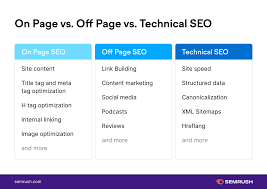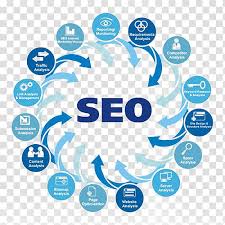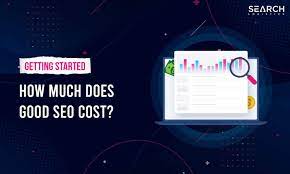The Essentials of On-Page SEO
Search Engine Optimization (SEO) is a fundamental aspect of digital marketing that involves various strategies to enhance a website’s visibility in search engine results. One crucial component of SEO is on-page optimization, which focuses on optimizing individual web pages to rank higher and attract more organic traffic. Let’s delve into the essentials of on-page SEO and how you can leverage it to boost your website’s performance.
Quality Content
Content is king in the world of SEO. High-quality, relevant, and engaging content not only attracts visitors but also signals search engines about the value of your website. Ensure your content is well-written, informative, and includes relevant keywords that align with your target audience’s search queries.
Title Tags and Meta Descriptions
Title tags and meta descriptions are HTML elements that provide concise summaries of web pages. Optimizing these elements with relevant keywords can improve click-through rates and help search engines understand the content of your pages better.
URL Structure
A clean and descriptive URL structure not only makes it easier for users to navigate your site but also benefits SEO. Use short, keyword-rich URLs that accurately reflect the content of each page to improve indexing and ranking.
Heading Tags
Heading tags (H1, H2, H3, etc.) help structure your content and make it more readable for both users and search engines. Use headings to break up content into logical sections and include relevant keywords to signal the importance of each section.
Image Optimization
Images play a crucial role in enhancing user experience on a website. Optimize images by using descriptive filenames, alt text attributes, and appropriate file sizes to improve loading times and make them more accessible to search engines.
Internal Linking
Internal linking refers to linking between pages within your website. By strategically linking related content together, you can improve navigation, distribute link equity throughout your site, and help search engines discover and index new pages more efficiently.
Mobile-Friendliness
In today’s mobile-centric world, ensuring that your website is mobile-friendly is essential for both user experience and SEO. Responsive design, fast loading times on mobile devices, and easy navigation are key factors that contribute to improved rankings in mobile search results.
In conclusion, on-page SEO plays a vital role in enhancing the visibility and performance of your website in search engine results pages (SERPs). By implementing these essential strategies effectively, you can optimise individual web pages for better rankings, increased organic traffic, and ultimately achieve your digital marketing goals.
8 Essential Tips for Effective On-Page SEO Optimisation
- Use relevant keywords naturally in your content.
- Optimise title tags with primary keywords.
- Ensure meta descriptions are compelling and include target keywords.
- Utilise header tags (H1, H2, etc.) to structure content logically.
- Incorporate internal linking to related pages on your site.
- Optimise images by using descriptive filenames and alt text.
- Improve page load speed for better user experience and SEO.
- Ensure your site is mobile-friendly and responsive.
Use relevant keywords naturally in your content.
To improve your on-page SEO, it is essential to incorporate relevant keywords naturally within your content. By strategically placing keywords that align with your target audience’s search queries, you can signal to search engines the relevance and value of your web pages. Avoid keyword stuffing and focus on creating high-quality, informative content that seamlessly integrates these keywords to enhance both user experience and search engine visibility. Remember, the key is to strike a balance between optimising for search engines and providing valuable information for your website visitors.
Optimise title tags with primary keywords.
To enhance the effectiveness of your on-page SEO strategy, it is crucial to optimise title tags with primary keywords. Title tags serve as a concise yet impactful summary of a web page’s content, influencing both user engagement and search engine rankings. By strategically incorporating relevant primary keywords into your title tags, you can signal to search engines the relevance of your content to specific search queries. This optimisation not only improves the visibility and click-through rates of your web pages but also contributes to a more targeted and effective SEO approach overall.
Ensure meta descriptions are compelling and include target keywords.
To enhance your on-page SEO performance, it is crucial to ensure that your meta descriptions are not only compelling but also include your target keywords. Meta descriptions serve as a brief summary of your web page in search engine results, enticing users to click through to your site. By incorporating relevant keywords into your meta descriptions, you can improve the visibility and relevance of your content to both search engines and potential visitors, ultimately driving more organic traffic to your website.
Utilise header tags (H1, H2, etc.) to structure content logically.
When it comes to on-page SEO, utilising header tags such as H1, H2, etc., is crucial for structuring content logically. By incorporating these tags appropriately, you not only enhance the readability and organisation of your content but also provide search engines with valuable information about the hierarchy and relevance of different sections on your web page. This strategic use of header tags helps improve user experience, boosts SEO performance, and signals the importance of key topics to both visitors and search engine crawlers.
Incorporate internal linking to related pages on your site.
Incorporating internal linking to related pages on your site is a valuable on-page SEO strategy that can enhance user experience and improve search engine visibility. By strategically linking relevant content within your website, you not only help users navigate seamlessly between related topics but also distribute link equity throughout your site. This practice not only encourages visitors to explore more of your content but also assists search engines in discovering and indexing new pages more efficiently, ultimately contributing to a stronger online presence and improved rankings.
Optimise images by using descriptive filenames and alt text.
Optimising images by using descriptive filenames and alt text is a crucial aspect of on-page SEO. When search engines crawl your website, they rely on image filenames and alt text to understand the content of your images. By using descriptive filenames that include relevant keywords and providing informative alt text, you not only improve the accessibility of your images for users with visual impairments but also enhance your chances of ranking higher in image search results. This simple yet effective practice can significantly boost your website’s SEO performance and overall user experience.
Improve page load speed for better user experience and SEO.
Enhancing page load speed is a crucial tip for effective on-page SEO and user experience. A fast-loading website not only provides visitors with a seamless browsing experience but also signals search engines about the site’s quality and relevance. By optimising page load speed through techniques such as image compression, minifying code, and leveraging browser caching, you can improve user engagement, reduce bounce rates, and boost your site’s ranking in search engine results. Prioritising page speed not only benefits SEO efforts but also ensures that visitors have a positive interaction with your website, ultimately leading to higher conversions and improved online visibility.
Ensure your site is mobile-friendly and responsive.
In the realm of on-page SEO, a crucial tip is to ensure that your website is mobile-friendly and responsive. With the increasing use of mobile devices for browsing the internet, it is imperative that your site is optimised for various screen sizes and devices. A mobile-friendly and responsive design not only enhances user experience but also signals search engines that your site is accessible and user-friendly across different platforms. By prioritising mobile-friendliness in your on-page SEO strategy, you can improve your site’s visibility, attract more organic traffic, and enhance overall performance in search engine rankings.




